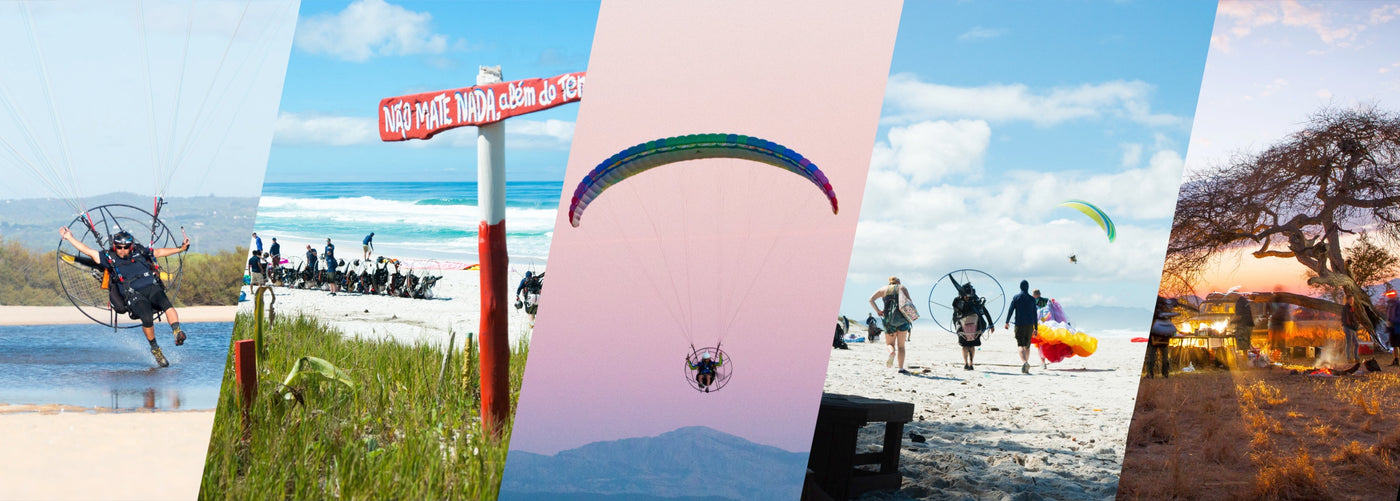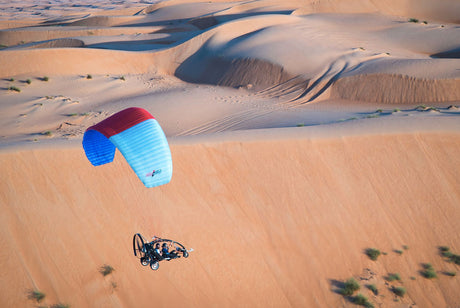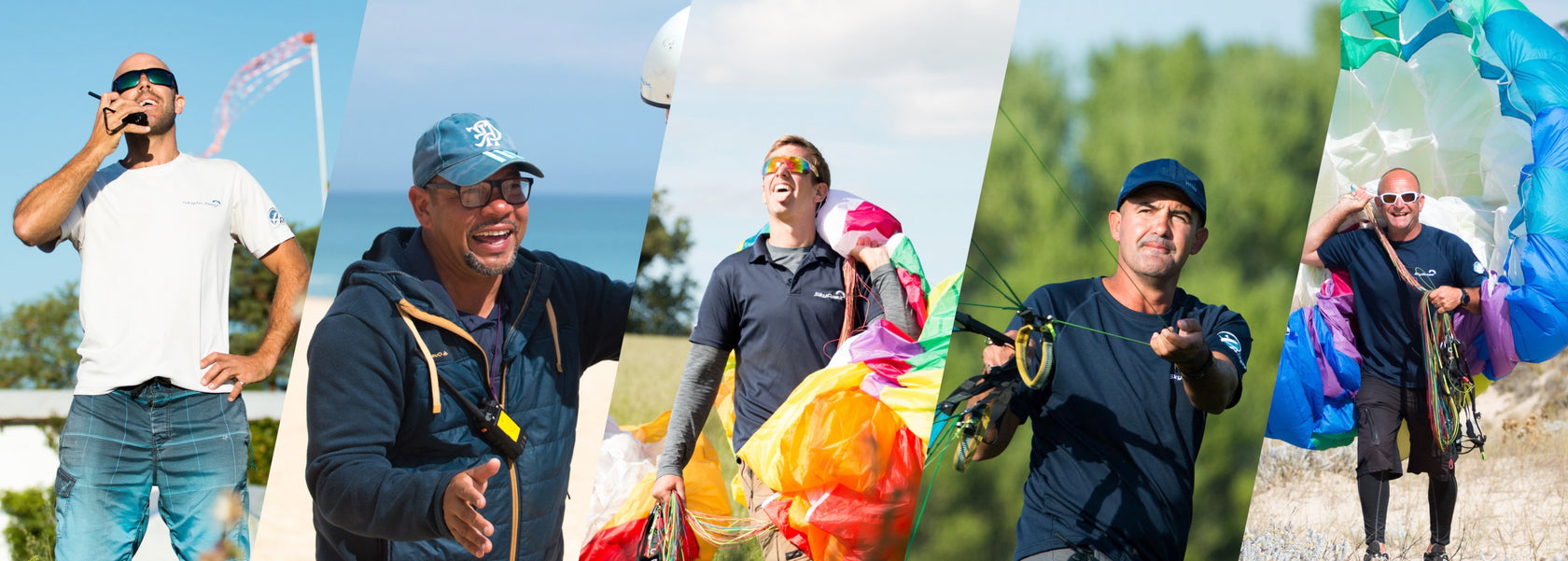Bringing SkyWeek Namibia to life was no small feat. Sam McConnell from MCXpeditions first pitched the idea to me back in 2020, and it quickly became clear that his expertise would be the key to making it happen. With over 30 years of experience as a safari guide in Namibia, Sam’s deep knowledge of the terrain, weather patterns, and local networks was invaluable. His connections opened doors that would have otherwise remained closed, and his relentless dedication kept the dream alive. After five years of meticulous planning, refining logistics, and overcoming countless challenges, we finally set our sights on March 2025, and decided to run not only one, but two expeditions!
I joined Sam and Ricardo to help run the first trip, which consisted of seven British pilots, most of whom had been trained by SkySchool. After passing the exam and medical checks, as well as rebuilding the paramotors, we set off in the ‘Mofana’ toward our first destination, called Rooisands. At 1100 meters above sea level, it provided a stunning, yet technically challenging location for our first flights of the trip. There have not been many times in my flying career when a landscape has truly taken my breath away, but this was one of them. Stretching endlessly in every direction, there was nothing but raw, untouched wilderness without a single sign of civilisation!

Above: Alex's first flight of the trip at Rooisands
The support vehicles then transported us to Sesriem, on the edge of the Namib Desert, believed to be the world’s oldest desert. From our campsite, we could quite literally roll out of our tents and take off just 100 meters away! Flying in proximity to Namibia’s ancient dunes was an experience beyond words. This was followed by a 40km cross-country flight, which I completed with two other pilots due to the technical challenge of taking off in nil wind. We arrived in Solitaire, an aptly named, incredibly remote outpost, where we were warmly welcomed by the owner, a fellow aviator from the USA. He granted us permission to fly below the standard 500ft limit, provided we remained clear of the wildlife. However, that afternoon, as we relaxed by the swimming pool in 40-degree heat, we were suddenly hit by the most intense thunderstorm I’ve ever witnessed. Three towering cumulonimbus cells converged, unleashing a year’s worth of rain on our campsite in just two hours. Fortunately, the bar and restaurant were open, keeping spirits high despite the torrential downpour. The following day we woke to perfect flying conditions and also a green desert!

After flying in the morning, we headed to the coast at Swakopmund, where it was 20 degrees cooler due to the cold Benguela Current, which flows up from the Antarctic and significantly influences the region’s climate. After a night out in town, we woke early to fly up the Skeleton Coast but had to wait a few hours for the rain from the night before to stop. Once it cleared, all seven pilots, plus myself and Ricardo, were treated to an incredible 60km cross-country flight up the coast with a smooth tailwind all the way to Henties Bay. It was an unforgettable experience flying over shark-infested waters and various shipwrecks along this desolate stretch of coastline, where the desert meets the Atlantic Ocean.

Above: A Shipwreck on the Skeleton Coast Below: Alex landing on the Mofana


We eventually made it to Elephant Rock, which despite its name, did not have any elephants in its immediate vicinity. From here we had a grandstand view of the Brandburg Mountains, which made for an excellent backdrop during our cross country flight the following morning. Yet again all seven pilots managed to fly but due to one pilot running out of fuel we all ended up landing together slightly short of the intended destination. However, the beauty of flying in the desert is that you have landing options almost everywhere, meaning everyone had a safe landing.
The final flight of the trip took place at the spectacular Spitzkoppe, a massive granite rock formation more than 120 million years old, rising 1728 meters above sea level. Just like at Sesriem, we could roll out of bed, walk 100 meters to the flying site, and take off!

Through it all, the camaraderie of the team made the journey even more special, with everyone getting stuck in to the daily routine of breaking and setting up camp. Sam’s extensive knowledge of Namibia’s landscapes, weather patterns, and hidden gems ensured every moment was perfectly curated. Ricardo’s energy and skill added an extra layer of safety to the trip. The local safari company, Kauirmbi Expeditions, led by Gert and Alda Steyn, with Francois the driver, and Dina, the kitchen assistant, ensured everyone was well taken care of throughout the trip. Finally, we owe a huge amount of gratitude to Hennie from MICAN, who helped ensure we met all the necessary criteria to run the trip legally.
Reflecting on this expedition, it’s clear that Namibia is a dream destination for paramotor pilots. The combination of dramatic landscapes, wide-open skies, and the thrill of flying in such a remote part of the world makes for an adventure like no other. Thanks to Sam’s dedication and expertise, we were able to experience this incredible country in a way few people ever have. For those seeking true adventure, this journey proved that the wait, and the effort, was absolutely worth it. We’ll definitely be back in 2026! Those interested in joining us on next year’s trip can register by emailing me at alex@skyopsx.com and in the meantime stay tuned for the film, which will be released on our YouTube Channel.
Find out more about our SkyWeek trips.
Below: Some of the stunning photos taken by Patrick Williamson on the trip



















